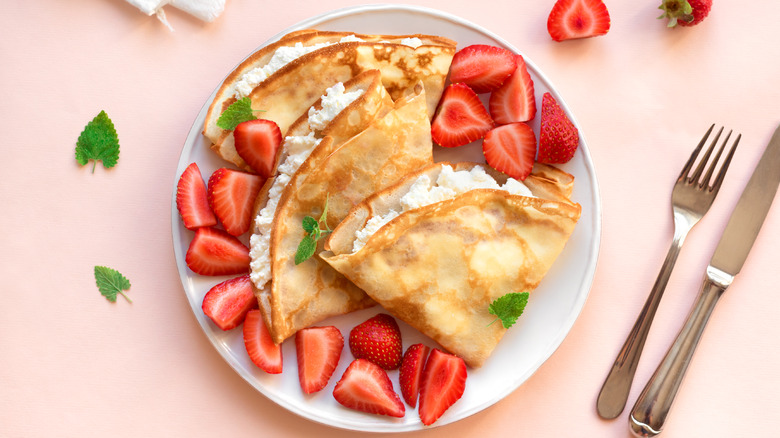The Only Flour Julia Child Used To Make Velvety Crepes
As any self-respecting breakfast lover will tell you, crepes — not to be confused with pancakes — are one breakfast staple that are as versatile as they are delicious. Made from a simple mixture of butter, flour, sugar, and milk, the pastry's paper-thin, yet slightly crispy, consistency has led to popularity the world over since its invention in France. While crepes are mostly associated with sweet fillings like strawberries and vanilla cream, the dish can also be prepared using a savory crepe recipe with ingredients such as spinach, mushrooms, and cheese.
Even though the ingredients used to make crepes are key items in most pantries, the thinness of crepes makes them pre-disposed to cooking challenges like sticking to a pan. This, coupled with the fact that crepes require cooks to hone their skillet-flipping skills, make the dish a surprisingly intimidating process for beginners. The secret to avoiding these common crepe pitfalls seems to be the quality of the ingredients that make up the batter, a theory supported by many chefs, including the French Chef herself, Julia Child.
Julia Child used a specific flour in her crepes
According to Julia Child, when it comes to the right flour for the perfect French crepe, only one variety will do. Child was known to use Wondra, a brand of low-protein instant flour (via Cuisine at Home). Wondra's benefits have to do with the size of its grains, which contribute to the time crepe batter must be left to stand. The brand's fine grains allow it to better absorb more moisture from the batter in a shorter amount of time, meaning that crepes made with Wondra stand for a shorter time before they are cooked. In comparison, batter made with all-purpose flour will need to stand for longer, according to Cuisine at Home.
Allowing crepe batter to rest is considered one of the most important steps in crepe making, as this step allows air bubbles in the batter to dissolve. When the air bubbles dissolve, it creates the delicate consistency the pastries are famous for (via Kitchn). Crepes will come out nice and tender when the flour is able to fully absorb the liquid from the batter (per YouTube). A flour that can speed up this process makes crepes easier to bake overall, which is probably why chefs like Child are so particular about the brand used in their recipes.

